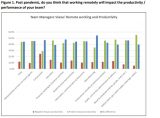Further results from WDC-NUIG Annual Remote Working Survey 2021
The second annual national remote working survey in Ireland was published in May 2021 and the key findings were reported widely. The survey gathered responses from over 6,400 employees, examining their experience of remote working one year after lockdown[1]. The report was published by the researchers at the Western Development Commission and the Whitaker Institute at NUI Galway and is available here.
One of the key findings was that the vast majority of respondents (95.5%) indicated that they would like to continue to work remotely for some or all the time after the crisis. Team managers were asked how their organisation planned to work post pandemic. Of those who reported that their organisations had decided how their team will work post pandemic, 78% indicated that they are planning to work in a hybrid way with some remote working and some onsite[2].
Before the pandemic one of the often-cited concerns of employers in relation to remote working was a perceived possible negative impact on productivity. The enforced working from home regime because of the pandemic, afforded employers an opportunity to test this theory and provides valuable insights on the productivity effects.
In the WDC-NUIG survey, during the pandemic, 68% of respondents agree or strongly agree that working remotely increases productivity. Also in the survey 44% of team managers feel that working remotely will have a positive impact on higher productivity performance, while another 44% believe productivity will be the same.
Further Analysis: Sectoral Differences?
What is not available in the initial report is detail on sectoral differences. It is often considered that there is likely to be significant differences across sectors, both in the capacity of the sector and the ability of different roles to be performed remotely.
For example the sectors of hospitality and retail are often considered sectors which will largely not support a large degree of remote working. In reality it is not just the sectors in which people are employed that will reflect ability to work remotely, but also the occupations within these sectors. For example, an accounts administrator working in a retail or hospitality business may well be able to perform equally well remotely as if they worked in a finance company. Nonetheless there are some sectors which are perceived to support remote working more than others such as the information and communication sector – which pre pandemic would have had higher rates of remote working than many other sectors.
Further analysis of the national remote working survey on differences across sectors is discussed below. We examine the employee and managers’ views on the perceived impact working remotely has on productivity and how it differs by sector.
Employees
Employees were asked whether they agreed or disagreed that working remotely increases their productivity. Overall, 68% reported that they agreed (35% strongly agreed, 33% agreed), while 11% disagreed (9% disagreed, 2% strongly disagreed). Over one fifth – 21% reported that working remotely made no difference to their productivity.
The table below illustrates the responses by sector, focussing on those sectors that are most significant in employment terms.
Employees across each sector report that at least 63% agree or strongly agree that working remotely increases their productivity. The Education sector has the lowest reported agreement and the highest level of disagreement – 14.7%, perhaps not surprising given the nature of the sector.
The sector with the highest level of employee agreement with the view that working remotely increases productivity is perhaps surprisingly – Retail and Wholesale, where nearly four fifths – 79% of employees agree or strongly agree that working remotely increases their productivity. Manufacturing is another sector with high rates of agreement – 70.9% which suggests that the roles people undertake are probably as important if not more so than the sector in which they work.

Examining the responses further, on average a fifth – 20.8% of employee respondents say that working remotely does not impact either way on their productivity. Across sectors the response is around one fifth, except for retail and wholesale where the response is just 12.5%.
The sectors reporting the highest level of disagreement with the view that working remotely increases productivity are Education – 14.7% and Financial, banking and insurance activities – 12.7%. The high rate in Education is perhaps not surprising. The responses within the Financial, banking and insurance sector is likely to reflect those roles requiring face-to-face interactions. More detailed data analysis may provide further insights along with the views of Team managers discussed below.
Managers
As part of the second annual WDC-NUIG survey we asked respondents did they have people management responsibilities (i.e. they had employees reporting into them). Over 2,100 respondents indicated that they had such responsibilities, and these were asked a series of questions about managing a team remotely.
Examining the issue of productivity, team managers were asked; Post pandemic, do you think that working remotely will impact the productivity / performance of your team? Table 2 below outlines the responses by selected sectors. It is also illustrated in the graph below.

Overall 44% of team managers across all sectors take a positive view of the impact of working remotely on team productivity and performance, while a similar share (44.4%) take the view that working remotely will make no difference to the productivity and performance of the team. This is not to say there are not challenges implementing remote working post the pandemic, some of which are documented in the WDC – NUIG Annual Survey results here , but obviously the view is widely held that the challenges can be managed so as to largely not impact on productivity.

The sectors where team mangers consider that working remotely will most positively impact team productivity and performance are Utilities, Public and Civil Service, Education and Retail and wholesale, all of which illustrate the diversity of roles within these sectors. It is also the case that in some of these sectors some if not many roles were ‘essential workers’ and continued working on the same basis as before.
Considering team managers views’ on where remote working will make no difference to team productivity, the highest share was reported in the Manufacturing sector (54.3%) and Construction sector (46.7%). This could also reflect the ‘essential’ nature of some of the occupations in these sectors. It also reflects the experience and learnings gathered through the enforced practice of remote working. Elsewhere WDC research has highlighted case studies of large manufacturing companies, where many roles had switched to a remote basis and will continue to operate on a remotely post pandemic due to the perceived benefits on productivity among other benefits, see here.
On average, across all sectors 11.7% reported that working remotely will negatively impact on the productivity/ performance of the team. This is similar to the employee response (Table 1) where 11.2% disagreed with the view that working remotely increases productivity.
Examining differences across sectors, the Construction, Education, Health and Social Work and Public and Civil Service administration and defence are those with the highest rates of team mangers perception of negative impacts of remote working, not surprising given the nature of much employment in these sectors.
Sectoral difference is just one aspect of remote working and the extent of its continued practice post pandemic. It is clear from the data above that the occupation is also a key factor. Over the coming months the WDC will analyse more detail from the WDC-NUIG Annual Remote Working Survey and will report findings on our Insights blogposts here. The WDC will also continue to monitor other data sources and highlight issues in future blogposts.
The views expressed here are those of the author and do not necessarily represent or reflect the views of the WDC.
[1] This was a self-selected sample and it is possible that there is a bias in favour of those who which to continue some form of remote working post pandemic.
[2] See p20, p21 Remote Working National Survey Phase III Report





